Financial Accounting Assessment: IFRS, Public Interest, and Assets
VerifiedAdded on 2021/06/17
|13
|2702
|36
Report
AI Summary
This report provides an in-depth analysis of advanced financial accounting principles. It begins by examining the conceptual framework, emphasizing the importance of understandability, relevance, and comparability in financial statements under IFRS. The report then delves into public interest, capture, and economic interest group theories of regulation, assessing their implications for corporate behavior and social responsibility. Furthermore, it explores FASB Statement No. 144, detailing its impact on accounting for the impairment or disposal of long-lived assets. The report concludes with a discussion on asset revaluation, outlining reasons against revaluation and its effects on financial statements, including the impact on shareholders' wealth, fair value determination, and the calculation of key financial ratios like return on equity. This comprehensive overview provides valuable insights into critical aspects of financial accounting and reporting.
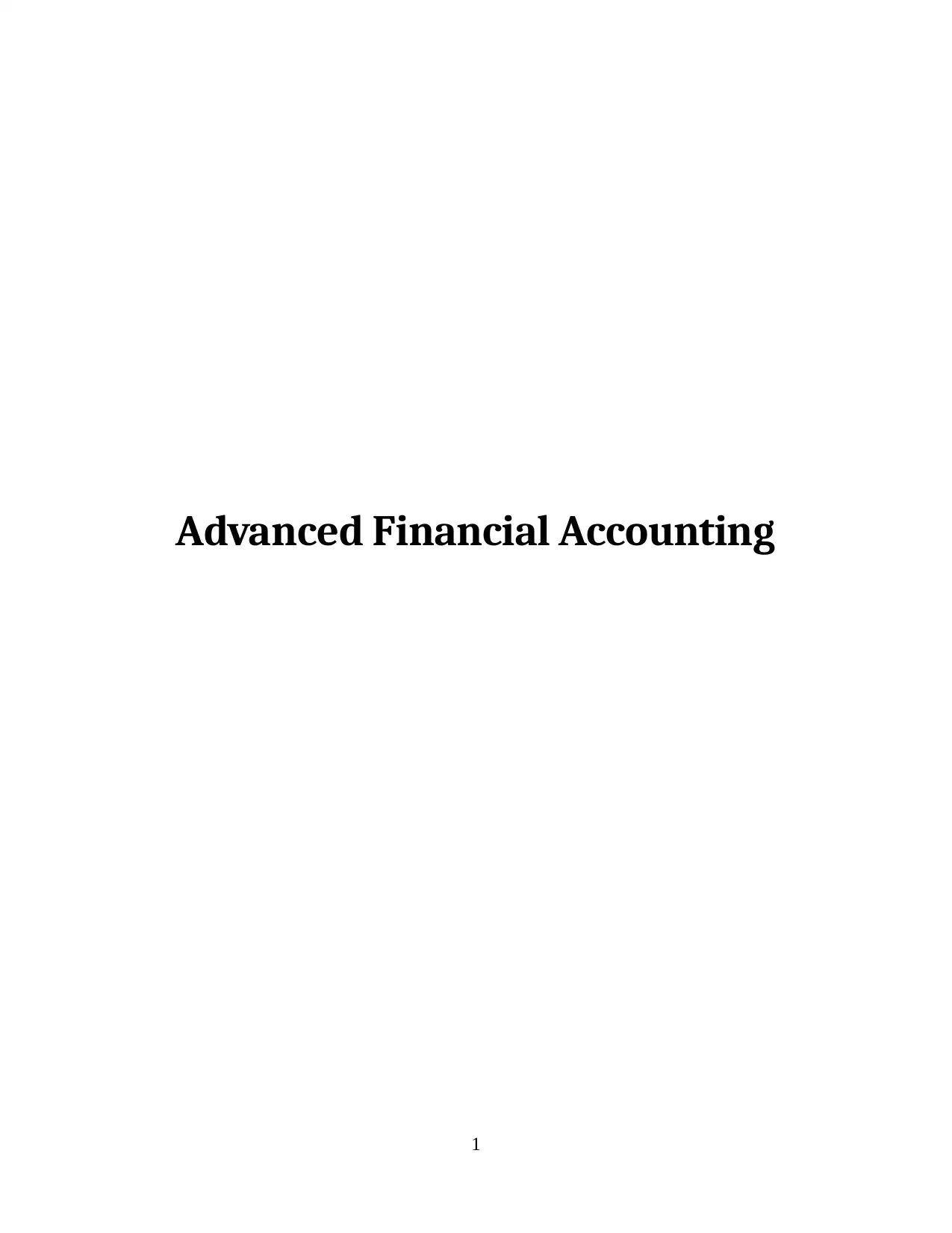
Advanced Financial Accounting
1
1
Paraphrase This Document
Need a fresh take? Get an instant paraphrase of this document with our AI Paraphraser
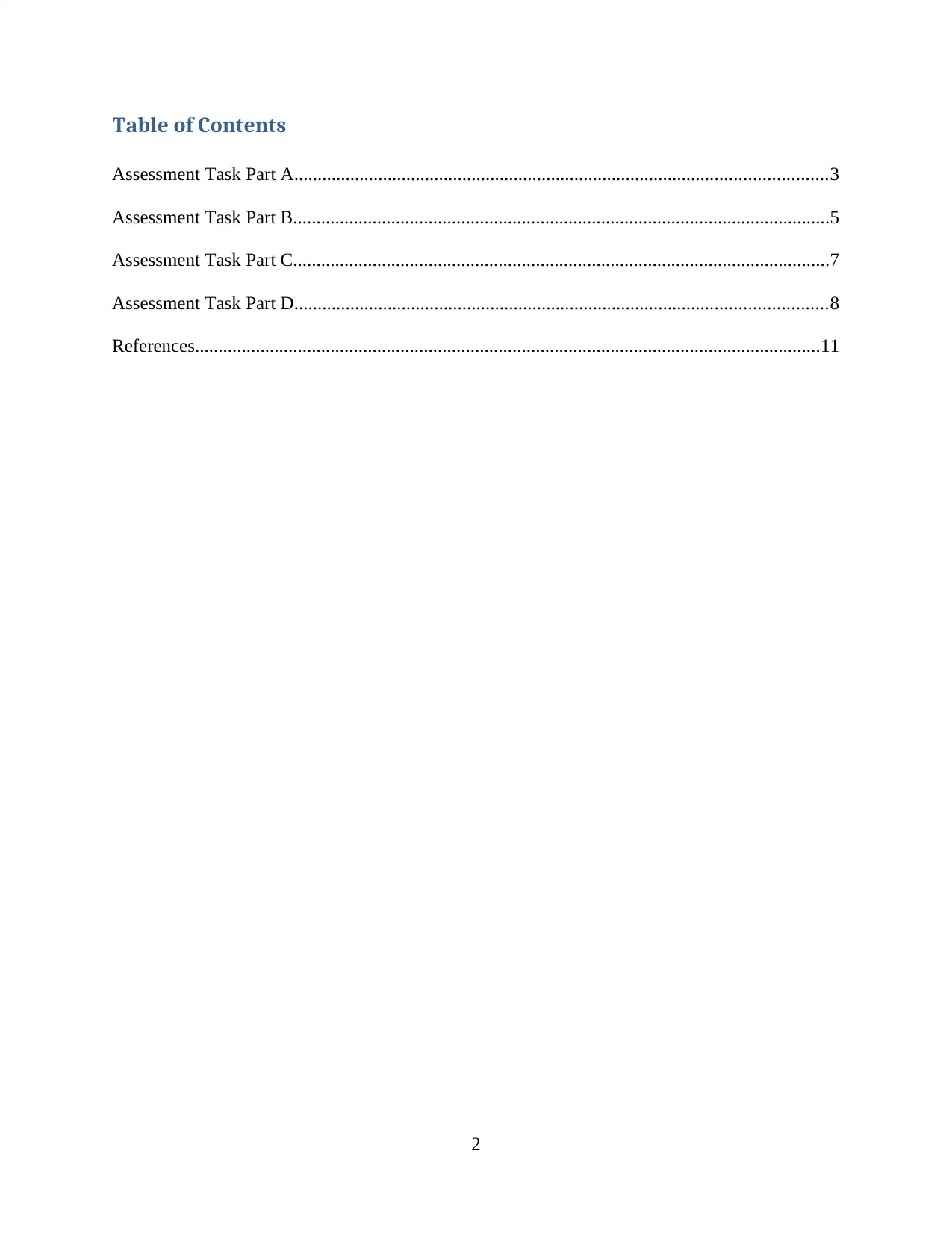
Table of Contents
Assessment Task Part A..................................................................................................................3
Assessment Task Part B...................................................................................................................5
Assessment Task Part C...................................................................................................................7
Assessment Task Part D..................................................................................................................8
References......................................................................................................................................11
2
Assessment Task Part A..................................................................................................................3
Assessment Task Part B...................................................................................................................5
Assessment Task Part C...................................................................................................................7
Assessment Task Part D..................................................................................................................8
References......................................................................................................................................11
2
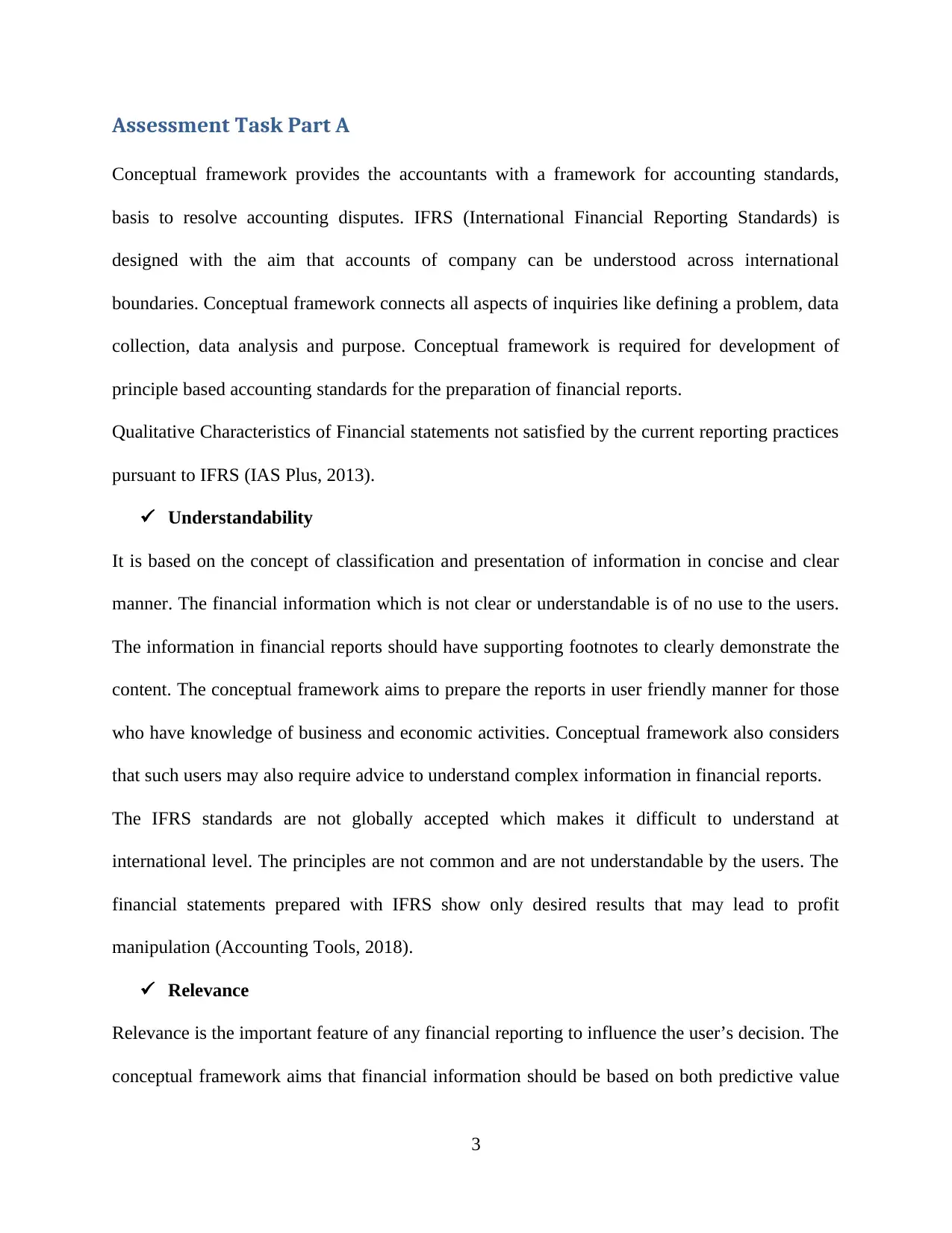
Assessment Task Part A
Conceptual framework provides the accountants with a framework for accounting standards,
basis to resolve accounting disputes. IFRS (International Financial Reporting Standards) is
designed with the aim that accounts of company can be understood across international
boundaries. Conceptual framework connects all aspects of inquiries like defining a problem, data
collection, data analysis and purpose. Conceptual framework is required for development of
principle based accounting standards for the preparation of financial reports.
Qualitative Characteristics of Financial statements not satisfied by the current reporting practices
pursuant to IFRS (IAS Plus, 2013).
Understandability
It is based on the concept of classification and presentation of information in concise and clear
manner. The financial information which is not clear or understandable is of no use to the users.
The information in financial reports should have supporting footnotes to clearly demonstrate the
content. The conceptual framework aims to prepare the reports in user friendly manner for those
who have knowledge of business and economic activities. Conceptual framework also considers
that such users may also require advice to understand complex information in financial reports.
The IFRS standards are not globally accepted which makes it difficult to understand at
international level. The principles are not common and are not understandable by the users. The
financial statements prepared with IFRS show only desired results that may lead to profit
manipulation (Accounting Tools, 2018).
Relevance
Relevance is the important feature of any financial reporting to influence the user’s decision. The
conceptual framework aims that financial information should be based on both predictive value
3
Conceptual framework provides the accountants with a framework for accounting standards,
basis to resolve accounting disputes. IFRS (International Financial Reporting Standards) is
designed with the aim that accounts of company can be understood across international
boundaries. Conceptual framework connects all aspects of inquiries like defining a problem, data
collection, data analysis and purpose. Conceptual framework is required for development of
principle based accounting standards for the preparation of financial reports.
Qualitative Characteristics of Financial statements not satisfied by the current reporting practices
pursuant to IFRS (IAS Plus, 2013).
Understandability
It is based on the concept of classification and presentation of information in concise and clear
manner. The financial information which is not clear or understandable is of no use to the users.
The information in financial reports should have supporting footnotes to clearly demonstrate the
content. The conceptual framework aims to prepare the reports in user friendly manner for those
who have knowledge of business and economic activities. Conceptual framework also considers
that such users may also require advice to understand complex information in financial reports.
The IFRS standards are not globally accepted which makes it difficult to understand at
international level. The principles are not common and are not understandable by the users. The
financial statements prepared with IFRS show only desired results that may lead to profit
manipulation (Accounting Tools, 2018).
Relevance
Relevance is the important feature of any financial reporting to influence the user’s decision. The
conceptual framework aims that financial information should be based on both predictive value
3
⊘ This is a preview!⊘
Do you want full access?
Subscribe today to unlock all pages.

Trusted by 1+ million students worldwide
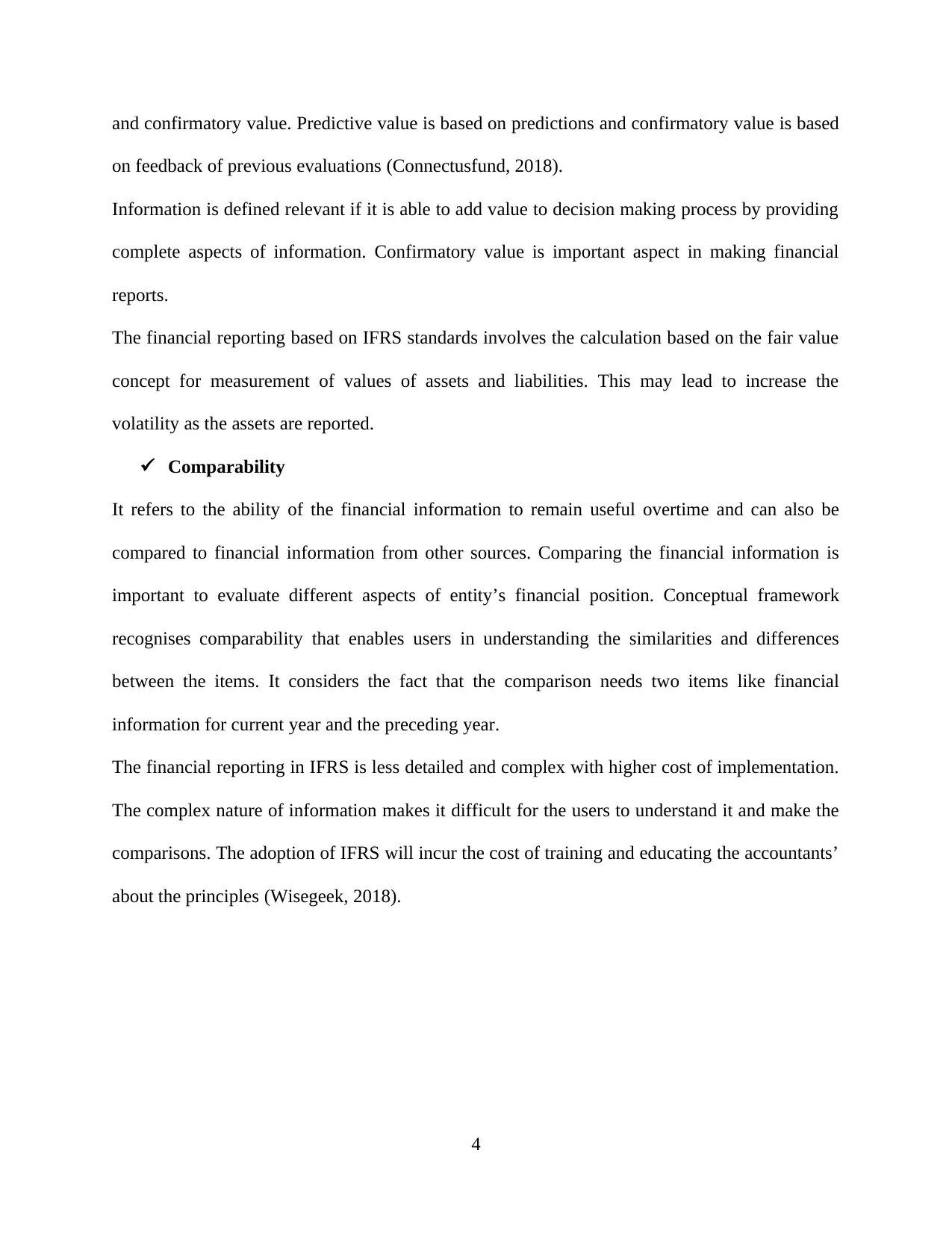
and confirmatory value. Predictive value is based on predictions and confirmatory value is based
on feedback of previous evaluations (Connectusfund, 2018).
Information is defined relevant if it is able to add value to decision making process by providing
complete aspects of information. Confirmatory value is important aspect in making financial
reports.
The financial reporting based on IFRS standards involves the calculation based on the fair value
concept for measurement of values of assets and liabilities. This may lead to increase the
volatility as the assets are reported.
Comparability
It refers to the ability of the financial information to remain useful overtime and can also be
compared to financial information from other sources. Comparing the financial information is
important to evaluate different aspects of entity’s financial position. Conceptual framework
recognises comparability that enables users in understanding the similarities and differences
between the items. It considers the fact that the comparison needs two items like financial
information for current year and the preceding year.
The financial reporting in IFRS is less detailed and complex with higher cost of implementation.
The complex nature of information makes it difficult for the users to understand it and make the
comparisons. The adoption of IFRS will incur the cost of training and educating the accountants’
about the principles (Wisegeek, 2018).
4
on feedback of previous evaluations (Connectusfund, 2018).
Information is defined relevant if it is able to add value to decision making process by providing
complete aspects of information. Confirmatory value is important aspect in making financial
reports.
The financial reporting based on IFRS standards involves the calculation based on the fair value
concept for measurement of values of assets and liabilities. This may lead to increase the
volatility as the assets are reported.
Comparability
It refers to the ability of the financial information to remain useful overtime and can also be
compared to financial information from other sources. Comparing the financial information is
important to evaluate different aspects of entity’s financial position. Conceptual framework
recognises comparability that enables users in understanding the similarities and differences
between the items. It considers the fact that the comparison needs two items like financial
information for current year and the preceding year.
The financial reporting in IFRS is less detailed and complex with higher cost of implementation.
The complex nature of information makes it difficult for the users to understand it and make the
comparisons. The adoption of IFRS will incur the cost of training and educating the accountants’
about the principles (Wisegeek, 2018).
4
Paraphrase This Document
Need a fresh take? Get an instant paraphrase of this document with our AI Paraphraser
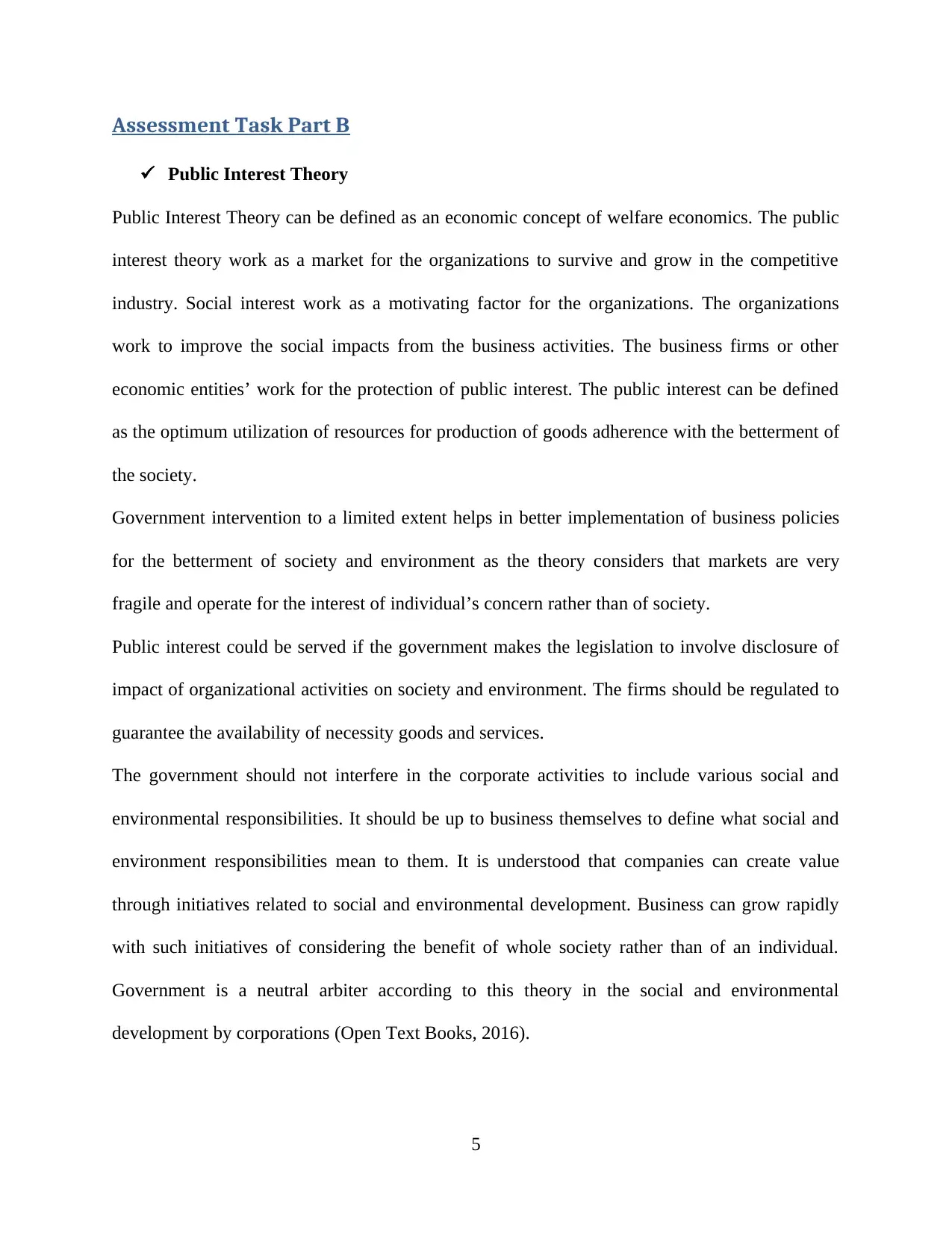
Assessment Task Part B
Public Interest Theory
Public Interest Theory can be defined as an economic concept of welfare economics. The public
interest theory work as a market for the organizations to survive and grow in the competitive
industry. Social interest work as a motivating factor for the organizations. The organizations
work to improve the social impacts from the business activities. The business firms or other
economic entities’ work for the protection of public interest. The public interest can be defined
as the optimum utilization of resources for production of goods adherence with the betterment of
the society.
Government intervention to a limited extent helps in better implementation of business policies
for the betterment of society and environment as the theory considers that markets are very
fragile and operate for the interest of individual’s concern rather than of society.
Public interest could be served if the government makes the legislation to involve disclosure of
impact of organizational activities on society and environment. The firms should be regulated to
guarantee the availability of necessity goods and services.
The government should not interfere in the corporate activities to include various social and
environmental responsibilities. It should be up to business themselves to define what social and
environment responsibilities mean to them. It is understood that companies can create value
through initiatives related to social and environmental development. Business can grow rapidly
with such initiatives of considering the benefit of whole society rather than of an individual.
Government is a neutral arbiter according to this theory in the social and environmental
development by corporations (Open Text Books, 2016).
5
Public Interest Theory
Public Interest Theory can be defined as an economic concept of welfare economics. The public
interest theory work as a market for the organizations to survive and grow in the competitive
industry. Social interest work as a motivating factor for the organizations. The organizations
work to improve the social impacts from the business activities. The business firms or other
economic entities’ work for the protection of public interest. The public interest can be defined
as the optimum utilization of resources for production of goods adherence with the betterment of
the society.
Government intervention to a limited extent helps in better implementation of business policies
for the betterment of society and environment as the theory considers that markets are very
fragile and operate for the interest of individual’s concern rather than of society.
Public interest could be served if the government makes the legislation to involve disclosure of
impact of organizational activities on society and environment. The firms should be regulated to
guarantee the availability of necessity goods and services.
The government should not interfere in the corporate activities to include various social and
environmental responsibilities. It should be up to business themselves to define what social and
environment responsibilities mean to them. It is understood that companies can create value
through initiatives related to social and environmental development. Business can grow rapidly
with such initiatives of considering the benefit of whole society rather than of an individual.
Government is a neutral arbiter according to this theory in the social and environmental
development by corporations (Open Text Books, 2016).
5
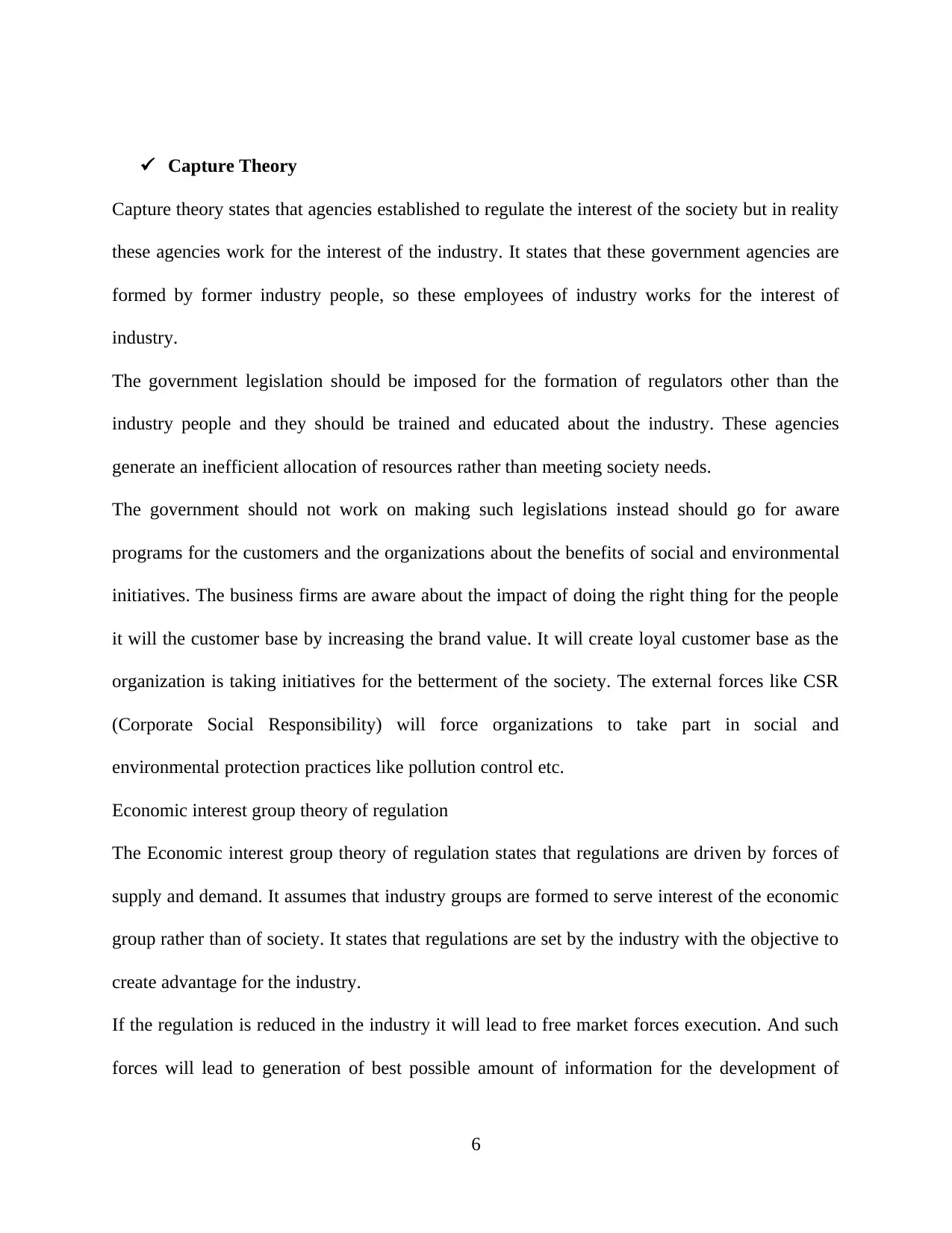
Capture Theory
Capture theory states that agencies established to regulate the interest of the society but in reality
these agencies work for the interest of the industry. It states that these government agencies are
formed by former industry people, so these employees of industry works for the interest of
industry.
The government legislation should be imposed for the formation of regulators other than the
industry people and they should be trained and educated about the industry. These agencies
generate an inefficient allocation of resources rather than meeting society needs.
The government should not work on making such legislations instead should go for aware
programs for the customers and the organizations about the benefits of social and environmental
initiatives. The business firms are aware about the impact of doing the right thing for the people
it will the customer base by increasing the brand value. It will create loyal customer base as the
organization is taking initiatives for the betterment of the society. The external forces like CSR
(Corporate Social Responsibility) will force organizations to take part in social and
environmental protection practices like pollution control etc.
Economic interest group theory of regulation
The Economic interest group theory of regulation states that regulations are driven by forces of
supply and demand. It assumes that industry groups are formed to serve interest of the economic
group rather than of society. It states that regulations are set by the industry with the objective to
create advantage for the industry.
If the regulation is reduced in the industry it will lead to free market forces execution. And such
forces will lead to generation of best possible amount of information for the development of
6
Capture theory states that agencies established to regulate the interest of the society but in reality
these agencies work for the interest of the industry. It states that these government agencies are
formed by former industry people, so these employees of industry works for the interest of
industry.
The government legislation should be imposed for the formation of regulators other than the
industry people and they should be trained and educated about the industry. These agencies
generate an inefficient allocation of resources rather than meeting society needs.
The government should not work on making such legislations instead should go for aware
programs for the customers and the organizations about the benefits of social and environmental
initiatives. The business firms are aware about the impact of doing the right thing for the people
it will the customer base by increasing the brand value. It will create loyal customer base as the
organization is taking initiatives for the betterment of the society. The external forces like CSR
(Corporate Social Responsibility) will force organizations to take part in social and
environmental protection practices like pollution control etc.
Economic interest group theory of regulation
The Economic interest group theory of regulation states that regulations are driven by forces of
supply and demand. It assumes that industry groups are formed to serve interest of the economic
group rather than of society. It states that regulations are set by the industry with the objective to
create advantage for the industry.
If the regulation is reduced in the industry it will lead to free market forces execution. And such
forces will lead to generation of best possible amount of information for the development of
6
⊘ This is a preview!⊘
Do you want full access?
Subscribe today to unlock all pages.

Trusted by 1+ million students worldwide
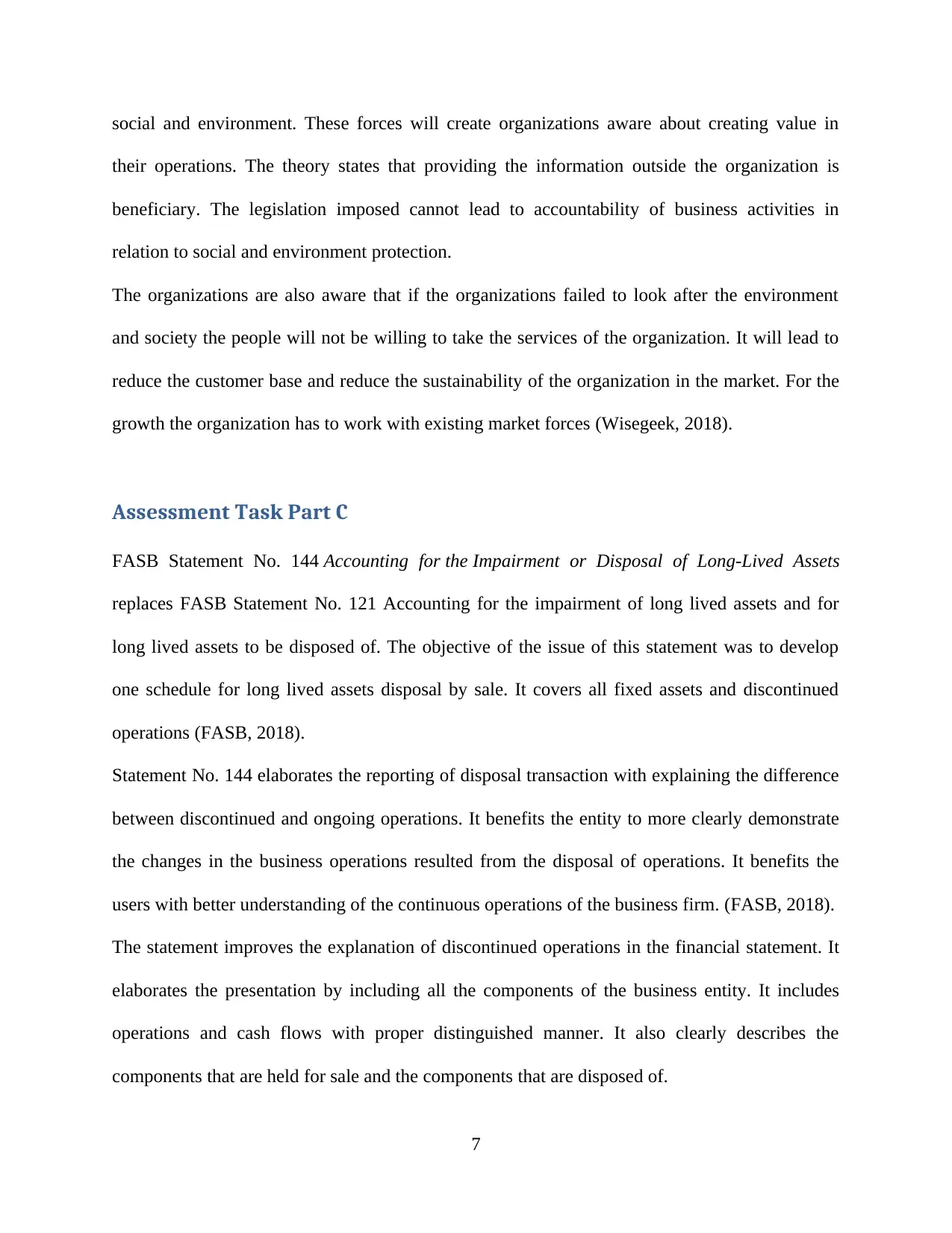
social and environment. These forces will create organizations aware about creating value in
their operations. The theory states that providing the information outside the organization is
beneficiary. The legislation imposed cannot lead to accountability of business activities in
relation to social and environment protection.
The organizations are also aware that if the organizations failed to look after the environment
and society the people will not be willing to take the services of the organization. It will lead to
reduce the customer base and reduce the sustainability of the organization in the market. For the
growth the organization has to work with existing market forces (Wisegeek, 2018).
Assessment Task Part C
FASB Statement No. 144 Accounting for the Impairment or Disposal of Long-Lived Assets
replaces FASB Statement No. 121 Accounting for the impairment of long lived assets and for
long lived assets to be disposed of. The objective of the issue of this statement was to develop
one schedule for long lived assets disposal by sale. It covers all fixed assets and discontinued
operations (FASB, 2018).
Statement No. 144 elaborates the reporting of disposal transaction with explaining the difference
between discontinued and ongoing operations. It benefits the entity to more clearly demonstrate
the changes in the business operations resulted from the disposal of operations. It benefits the
users with better understanding of the continuous operations of the business firm. (FASB, 2018).
The statement improves the explanation of discontinued operations in the financial statement. It
elaborates the presentation by including all the components of the business entity. It includes
operations and cash flows with proper distinguished manner. It also clearly describes the
components that are held for sale and the components that are disposed of.
7
their operations. The theory states that providing the information outside the organization is
beneficiary. The legislation imposed cannot lead to accountability of business activities in
relation to social and environment protection.
The organizations are also aware that if the organizations failed to look after the environment
and society the people will not be willing to take the services of the organization. It will lead to
reduce the customer base and reduce the sustainability of the organization in the market. For the
growth the organization has to work with existing market forces (Wisegeek, 2018).
Assessment Task Part C
FASB Statement No. 144 Accounting for the Impairment or Disposal of Long-Lived Assets
replaces FASB Statement No. 121 Accounting for the impairment of long lived assets and for
long lived assets to be disposed of. The objective of the issue of this statement was to develop
one schedule for long lived assets disposal by sale. It covers all fixed assets and discontinued
operations (FASB, 2018).
Statement No. 144 elaborates the reporting of disposal transaction with explaining the difference
between discontinued and ongoing operations. It benefits the entity to more clearly demonstrate
the changes in the business operations resulted from the disposal of operations. It benefits the
users with better understanding of the continuous operations of the business firm. (FASB, 2018).
The statement improves the explanation of discontinued operations in the financial statement. It
elaborates the presentation by including all the components of the business entity. It includes
operations and cash flows with proper distinguished manner. It also clearly describes the
components that are held for sale and the components that are disposed of.
7
Paraphrase This Document
Need a fresh take? Get an instant paraphrase of this document with our AI Paraphraser
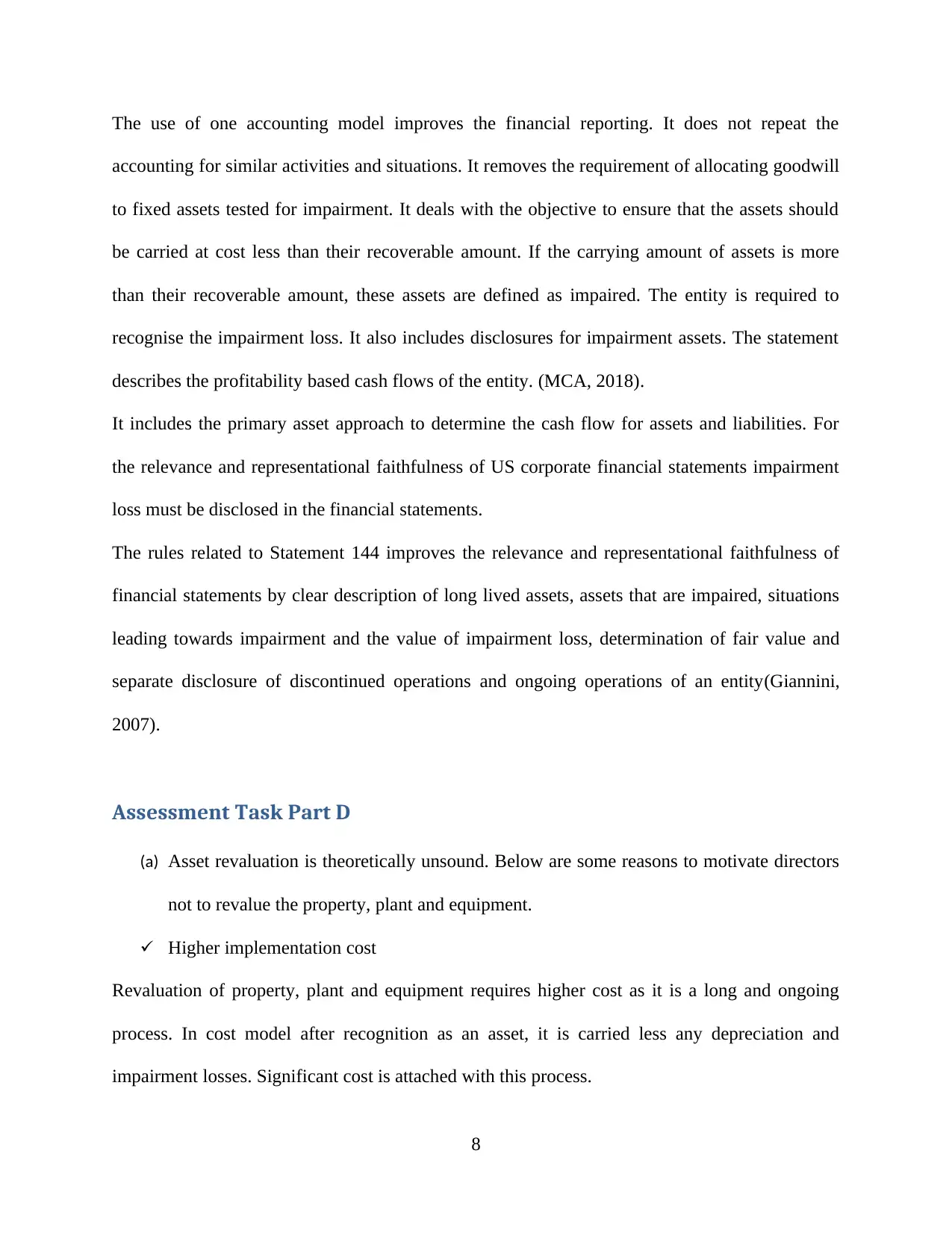
The use of one accounting model improves the financial reporting. It does not repeat the
accounting for similar activities and situations. It removes the requirement of allocating goodwill
to fixed assets tested for impairment. It deals with the objective to ensure that the assets should
be carried at cost less than their recoverable amount. If the carrying amount of assets is more
than their recoverable amount, these assets are defined as impaired. The entity is required to
recognise the impairment loss. It also includes disclosures for impairment assets. The statement
describes the profitability based cash flows of the entity. (MCA, 2018).
It includes the primary asset approach to determine the cash flow for assets and liabilities. For
the relevance and representational faithfulness of US corporate financial statements impairment
loss must be disclosed in the financial statements.
The rules related to Statement 144 improves the relevance and representational faithfulness of
financial statements by clear description of long lived assets, assets that are impaired, situations
leading towards impairment and the value of impairment loss, determination of fair value and
separate disclosure of discontinued operations and ongoing operations of an entity(Giannini,
2007).
Assessment Task Part D
(a) Asset revaluation is theoretically unsound. Below are some reasons to motivate directors
not to revalue the property, plant and equipment.
Higher implementation cost
Revaluation of property, plant and equipment requires higher cost as it is a long and ongoing
process. In cost model after recognition as an asset, it is carried less any depreciation and
impairment losses. Significant cost is attached with this process.
8
accounting for similar activities and situations. It removes the requirement of allocating goodwill
to fixed assets tested for impairment. It deals with the objective to ensure that the assets should
be carried at cost less than their recoverable amount. If the carrying amount of assets is more
than their recoverable amount, these assets are defined as impaired. The entity is required to
recognise the impairment loss. It also includes disclosures for impairment assets. The statement
describes the profitability based cash flows of the entity. (MCA, 2018).
It includes the primary asset approach to determine the cash flow for assets and liabilities. For
the relevance and representational faithfulness of US corporate financial statements impairment
loss must be disclosed in the financial statements.
The rules related to Statement 144 improves the relevance and representational faithfulness of
financial statements by clear description of long lived assets, assets that are impaired, situations
leading towards impairment and the value of impairment loss, determination of fair value and
separate disclosure of discontinued operations and ongoing operations of an entity(Giannini,
2007).
Assessment Task Part D
(a) Asset revaluation is theoretically unsound. Below are some reasons to motivate directors
not to revalue the property, plant and equipment.
Higher implementation cost
Revaluation of property, plant and equipment requires higher cost as it is a long and ongoing
process. In cost model after recognition as an asset, it is carried less any depreciation and
impairment losses. Significant cost is attached with this process.
8
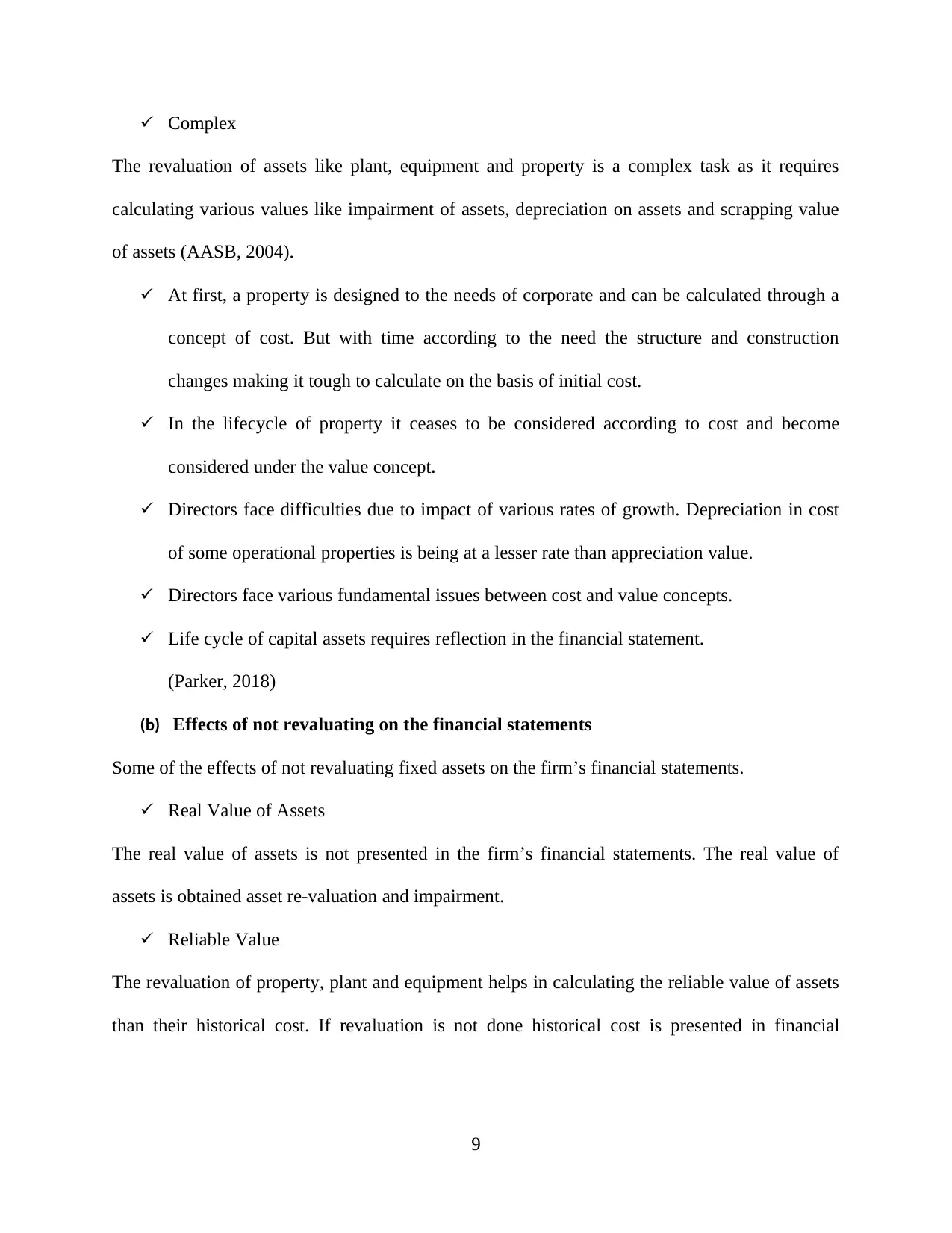
Complex
The revaluation of assets like plant, equipment and property is a complex task as it requires
calculating various values like impairment of assets, depreciation on assets and scrapping value
of assets (AASB, 2004).
At first, a property is designed to the needs of corporate and can be calculated through a
concept of cost. But with time according to the need the structure and construction
changes making it tough to calculate on the basis of initial cost.
In the lifecycle of property it ceases to be considered according to cost and become
considered under the value concept.
Directors face difficulties due to impact of various rates of growth. Depreciation in cost
of some operational properties is being at a lesser rate than appreciation value.
Directors face various fundamental issues between cost and value concepts.
Life cycle of capital assets requires reflection in the financial statement.
(Parker, 2018)
(b) Effects of not revaluating on the financial statements
Some of the effects of not revaluating fixed assets on the firm’s financial statements.
Real Value of Assets
The real value of assets is not presented in the firm’s financial statements. The real value of
assets is obtained asset re-valuation and impairment.
Reliable Value
The revaluation of property, plant and equipment helps in calculating the reliable value of assets
than their historical cost. If revaluation is not done historical cost is presented in financial
9
The revaluation of assets like plant, equipment and property is a complex task as it requires
calculating various values like impairment of assets, depreciation on assets and scrapping value
of assets (AASB, 2004).
At first, a property is designed to the needs of corporate and can be calculated through a
concept of cost. But with time according to the need the structure and construction
changes making it tough to calculate on the basis of initial cost.
In the lifecycle of property it ceases to be considered according to cost and become
considered under the value concept.
Directors face difficulties due to impact of various rates of growth. Depreciation in cost
of some operational properties is being at a lesser rate than appreciation value.
Directors face various fundamental issues between cost and value concepts.
Life cycle of capital assets requires reflection in the financial statement.
(Parker, 2018)
(b) Effects of not revaluating on the financial statements
Some of the effects of not revaluating fixed assets on the firm’s financial statements.
Real Value of Assets
The real value of assets is not presented in the firm’s financial statements. The real value of
assets is obtained asset re-valuation and impairment.
Reliable Value
The revaluation of property, plant and equipment helps in calculating the reliable value of assets
than their historical cost. If revaluation is not done historical cost is presented in financial
9
⊘ This is a preview!⊘
Do you want full access?
Subscribe today to unlock all pages.

Trusted by 1+ million students worldwide
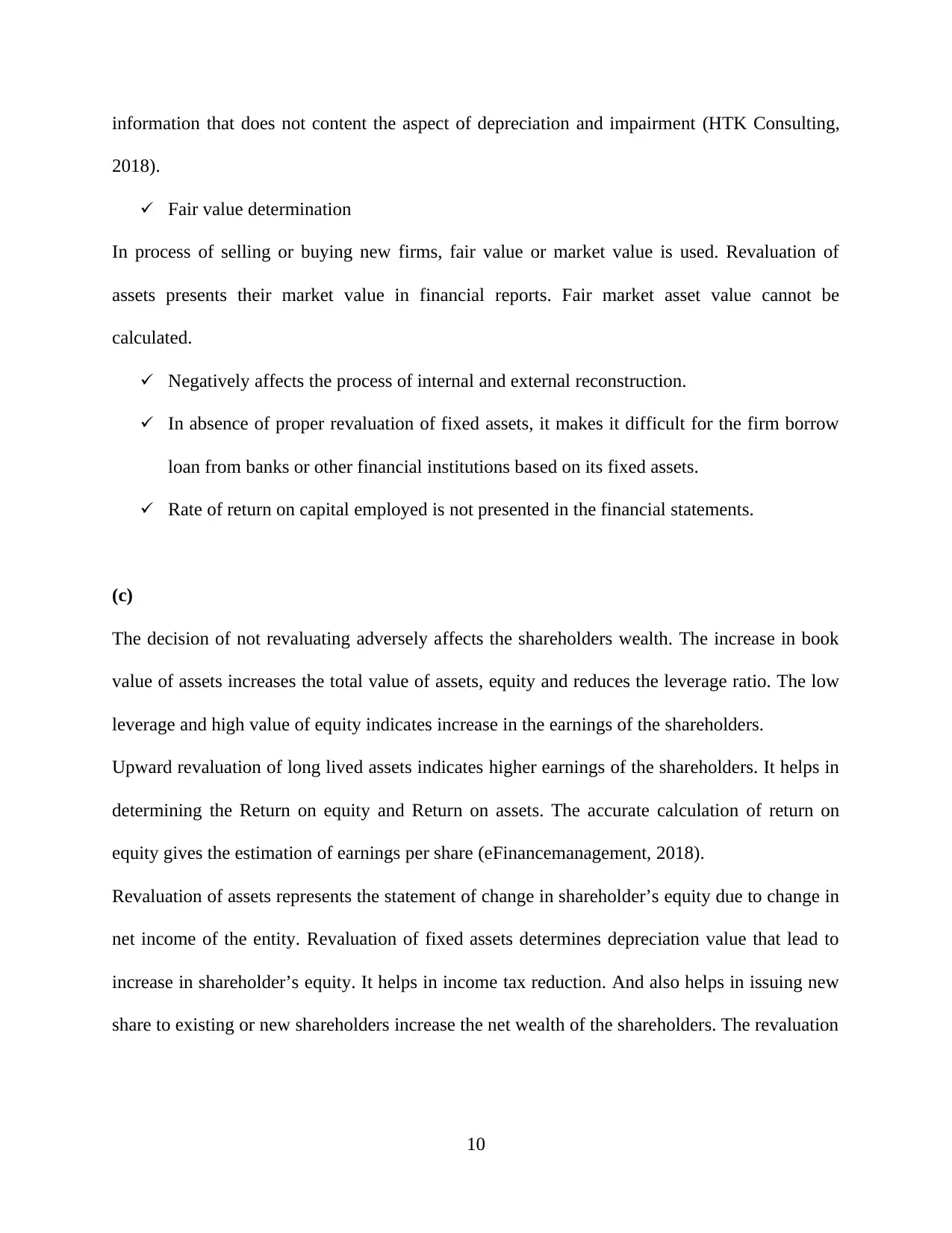
information that does not content the aspect of depreciation and impairment (HTK Consulting,
2018).
Fair value determination
In process of selling or buying new firms, fair value or market value is used. Revaluation of
assets presents their market value in financial reports. Fair market asset value cannot be
calculated.
Negatively affects the process of internal and external reconstruction.
In absence of proper revaluation of fixed assets, it makes it difficult for the firm borrow
loan from banks or other financial institutions based on its fixed assets.
Rate of return on capital employed is not presented in the financial statements.
(c)
The decision of not revaluating adversely affects the shareholders wealth. The increase in book
value of assets increases the total value of assets, equity and reduces the leverage ratio. The low
leverage and high value of equity indicates increase in the earnings of the shareholders.
Upward revaluation of long lived assets indicates higher earnings of the shareholders. It helps in
determining the Return on equity and Return on assets. The accurate calculation of return on
equity gives the estimation of earnings per share (eFinancemanagement, 2018).
Revaluation of assets represents the statement of change in shareholder’s equity due to change in
net income of the entity. Revaluation of fixed assets determines depreciation value that lead to
increase in shareholder’s equity. It helps in income tax reduction. And also helps in issuing new
share to existing or new shareholders increase the net wealth of the shareholders. The revaluation
10
2018).
Fair value determination
In process of selling or buying new firms, fair value or market value is used. Revaluation of
assets presents their market value in financial reports. Fair market asset value cannot be
calculated.
Negatively affects the process of internal and external reconstruction.
In absence of proper revaluation of fixed assets, it makes it difficult for the firm borrow
loan from banks or other financial institutions based on its fixed assets.
Rate of return on capital employed is not presented in the financial statements.
(c)
The decision of not revaluating adversely affects the shareholders wealth. The increase in book
value of assets increases the total value of assets, equity and reduces the leverage ratio. The low
leverage and high value of equity indicates increase in the earnings of the shareholders.
Upward revaluation of long lived assets indicates higher earnings of the shareholders. It helps in
determining the Return on equity and Return on assets. The accurate calculation of return on
equity gives the estimation of earnings per share (eFinancemanagement, 2018).
Revaluation of assets represents the statement of change in shareholder’s equity due to change in
net income of the entity. Revaluation of fixed assets determines depreciation value that lead to
increase in shareholder’s equity. It helps in income tax reduction. And also helps in issuing new
share to existing or new shareholders increase the net wealth of the shareholders. The revaluation
10
Paraphrase This Document
Need a fresh take? Get an instant paraphrase of this document with our AI Paraphraser
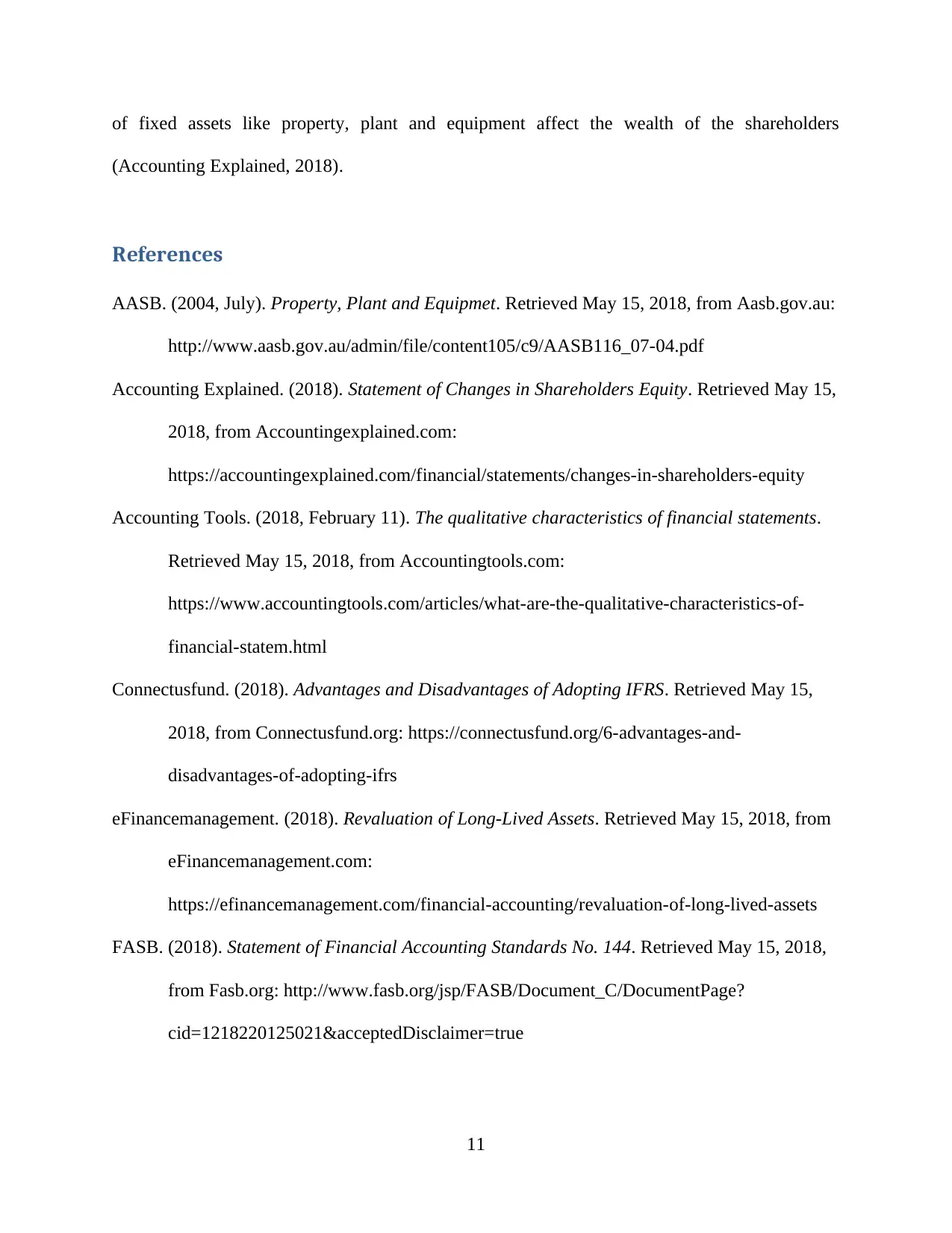
of fixed assets like property, plant and equipment affect the wealth of the shareholders
(Accounting Explained, 2018).
References
AASB. (2004, July). Property, Plant and Equipmet. Retrieved May 15, 2018, from Aasb.gov.au:
http://www.aasb.gov.au/admin/file/content105/c9/AASB116_07-04.pdf
Accounting Explained. (2018). Statement of Changes in Shareholders Equity. Retrieved May 15,
2018, from Accountingexplained.com:
https://accountingexplained.com/financial/statements/changes-in-shareholders-equity
Accounting Tools. (2018, February 11). The qualitative characteristics of financial statements.
Retrieved May 15, 2018, from Accountingtools.com:
https://www.accountingtools.com/articles/what-are-the-qualitative-characteristics-of-
financial-statem.html
Connectusfund. (2018). Advantages and Disadvantages of Adopting IFRS. Retrieved May 15,
2018, from Connectusfund.org: https://connectusfund.org/6-advantages-and-
disadvantages-of-adopting-ifrs
eFinancemanagement. (2018). Revaluation of Long-Lived Assets. Retrieved May 15, 2018, from
eFinancemanagement.com:
https://efinancemanagement.com/financial-accounting/revaluation-of-long-lived-assets
FASB. (2018). Statement of Financial Accounting Standards No. 144. Retrieved May 15, 2018,
from Fasb.org: http://www.fasb.org/jsp/FASB/Document_C/DocumentPage?
cid=1218220125021&acceptedDisclaimer=true
11
(Accounting Explained, 2018).
References
AASB. (2004, July). Property, Plant and Equipmet. Retrieved May 15, 2018, from Aasb.gov.au:
http://www.aasb.gov.au/admin/file/content105/c9/AASB116_07-04.pdf
Accounting Explained. (2018). Statement of Changes in Shareholders Equity. Retrieved May 15,
2018, from Accountingexplained.com:
https://accountingexplained.com/financial/statements/changes-in-shareholders-equity
Accounting Tools. (2018, February 11). The qualitative characteristics of financial statements.
Retrieved May 15, 2018, from Accountingtools.com:
https://www.accountingtools.com/articles/what-are-the-qualitative-characteristics-of-
financial-statem.html
Connectusfund. (2018). Advantages and Disadvantages of Adopting IFRS. Retrieved May 15,
2018, from Connectusfund.org: https://connectusfund.org/6-advantages-and-
disadvantages-of-adopting-ifrs
eFinancemanagement. (2018). Revaluation of Long-Lived Assets. Retrieved May 15, 2018, from
eFinancemanagement.com:
https://efinancemanagement.com/financial-accounting/revaluation-of-long-lived-assets
FASB. (2018). Statement of Financial Accounting Standards No. 144. Retrieved May 15, 2018,
from Fasb.org: http://www.fasb.org/jsp/FASB/Document_C/DocumentPage?
cid=1218220125021&acceptedDisclaimer=true
11
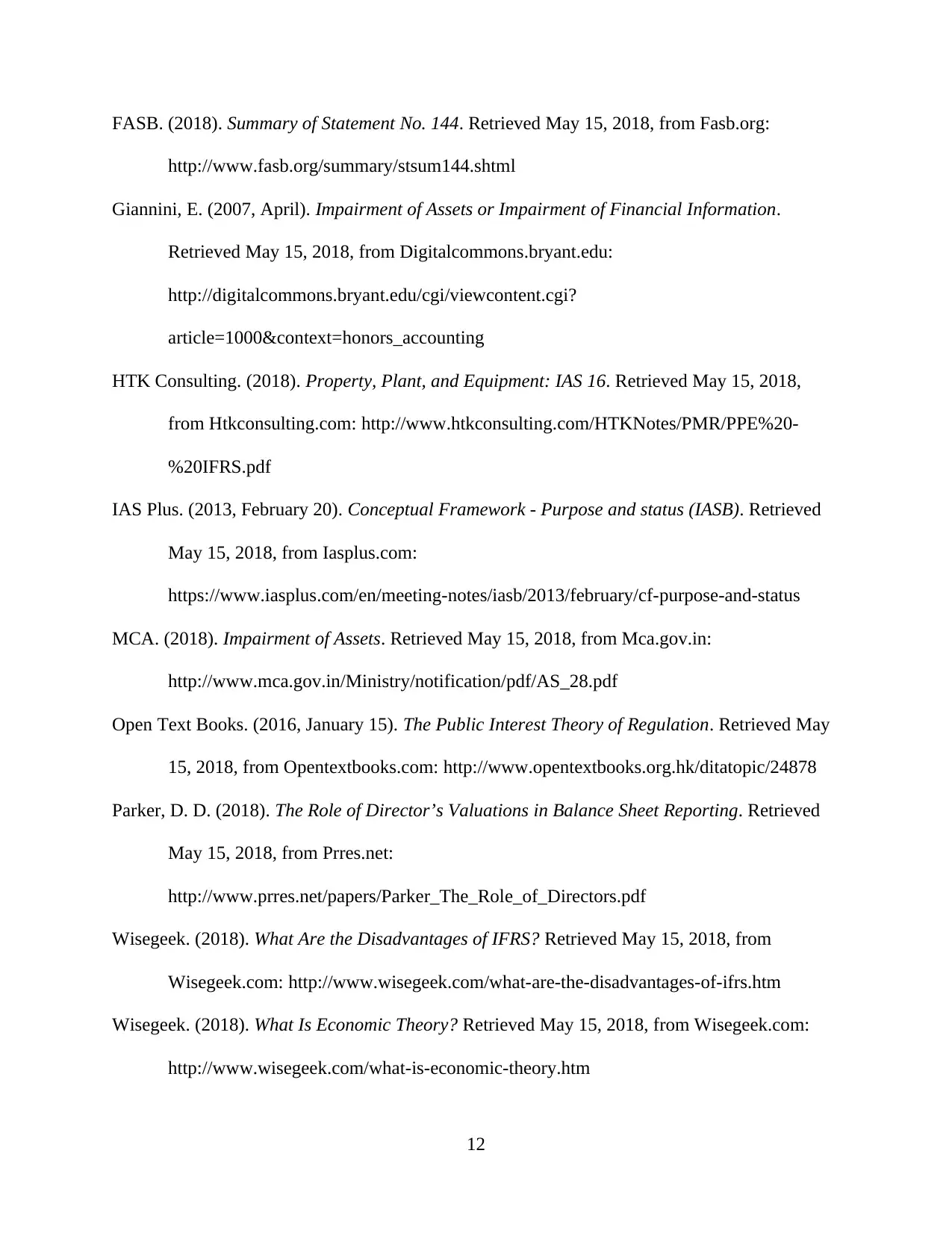
FASB. (2018). Summary of Statement No. 144. Retrieved May 15, 2018, from Fasb.org:
http://www.fasb.org/summary/stsum144.shtml
Giannini, E. (2007, April). Impairment of Assets or Impairment of Financial Information.
Retrieved May 15, 2018, from Digitalcommons.bryant.edu:
http://digitalcommons.bryant.edu/cgi/viewcontent.cgi?
article=1000&context=honors_accounting
HTK Consulting. (2018). Property, Plant, and Equipment: IAS 16. Retrieved May 15, 2018,
from Htkconsulting.com: http://www.htkconsulting.com/HTKNotes/PMR/PPE%20-
%20IFRS.pdf
IAS Plus. (2013, February 20). Conceptual Framework - Purpose and status (IASB). Retrieved
May 15, 2018, from Iasplus.com:
https://www.iasplus.com/en/meeting-notes/iasb/2013/february/cf-purpose-and-status
MCA. (2018). Impairment of Assets. Retrieved May 15, 2018, from Mca.gov.in:
http://www.mca.gov.in/Ministry/notification/pdf/AS_28.pdf
Open Text Books. (2016, January 15). The Public Interest Theory of Regulation. Retrieved May
15, 2018, from Opentextbooks.com: http://www.opentextbooks.org.hk/ditatopic/24878
Parker, D. D. (2018). The Role of Director’s Valuations in Balance Sheet Reporting. Retrieved
May 15, 2018, from Prres.net:
http://www.prres.net/papers/Parker_The_Role_of_Directors.pdf
Wisegeek. (2018). What Are the Disadvantages of IFRS? Retrieved May 15, 2018, from
Wisegeek.com: http://www.wisegeek.com/what-are-the-disadvantages-of-ifrs.htm
Wisegeek. (2018). What Is Economic Theory? Retrieved May 15, 2018, from Wisegeek.com:
http://www.wisegeek.com/what-is-economic-theory.htm
12
http://www.fasb.org/summary/stsum144.shtml
Giannini, E. (2007, April). Impairment of Assets or Impairment of Financial Information.
Retrieved May 15, 2018, from Digitalcommons.bryant.edu:
http://digitalcommons.bryant.edu/cgi/viewcontent.cgi?
article=1000&context=honors_accounting
HTK Consulting. (2018). Property, Plant, and Equipment: IAS 16. Retrieved May 15, 2018,
from Htkconsulting.com: http://www.htkconsulting.com/HTKNotes/PMR/PPE%20-
%20IFRS.pdf
IAS Plus. (2013, February 20). Conceptual Framework - Purpose and status (IASB). Retrieved
May 15, 2018, from Iasplus.com:
https://www.iasplus.com/en/meeting-notes/iasb/2013/february/cf-purpose-and-status
MCA. (2018). Impairment of Assets. Retrieved May 15, 2018, from Mca.gov.in:
http://www.mca.gov.in/Ministry/notification/pdf/AS_28.pdf
Open Text Books. (2016, January 15). The Public Interest Theory of Regulation. Retrieved May
15, 2018, from Opentextbooks.com: http://www.opentextbooks.org.hk/ditatopic/24878
Parker, D. D. (2018). The Role of Director’s Valuations in Balance Sheet Reporting. Retrieved
May 15, 2018, from Prres.net:
http://www.prres.net/papers/Parker_The_Role_of_Directors.pdf
Wisegeek. (2018). What Are the Disadvantages of IFRS? Retrieved May 15, 2018, from
Wisegeek.com: http://www.wisegeek.com/what-are-the-disadvantages-of-ifrs.htm
Wisegeek. (2018). What Is Economic Theory? Retrieved May 15, 2018, from Wisegeek.com:
http://www.wisegeek.com/what-is-economic-theory.htm
12
⊘ This is a preview!⊘
Do you want full access?
Subscribe today to unlock all pages.

Trusted by 1+ million students worldwide
1 out of 13
Related Documents
Your All-in-One AI-Powered Toolkit for Academic Success.
+13062052269
info@desklib.com
Available 24*7 on WhatsApp / Email
![[object Object]](/_next/static/media/star-bottom.7253800d.svg)
Unlock your academic potential
Copyright © 2020–2025 A2Z Services. All Rights Reserved. Developed and managed by ZUCOL.




